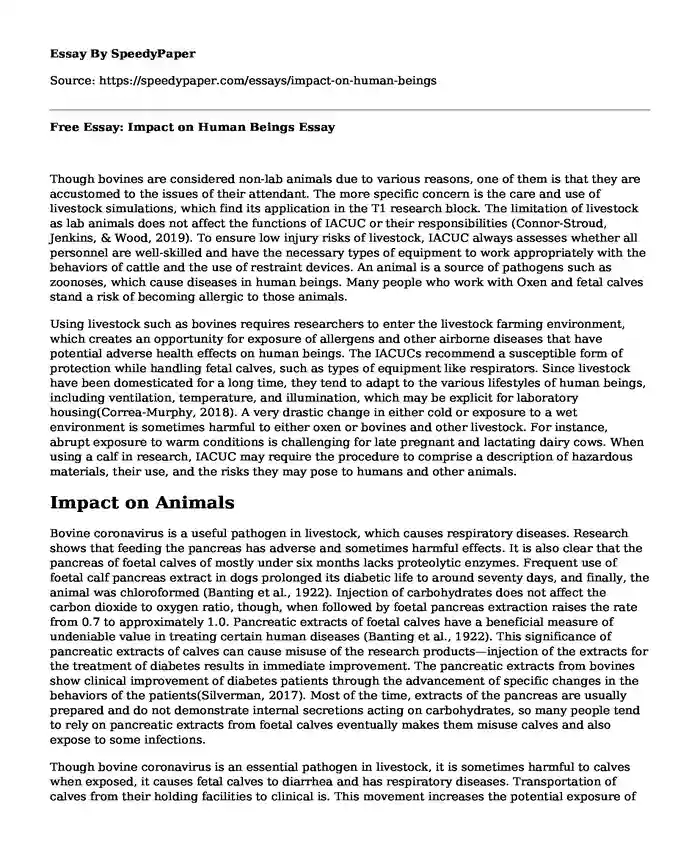
| Type of paper: | Essay |
| Categories: | Farming Animals Human Essays by wordcount Essays by pagecount |
| Pages: | 3 |
| Wordcount: | 662 words |
Though bovines are considered non-lab animals due to various reasons, one of them is that they are accustomed to the issues of their attendant. The more specific concern is the care and use of livestock simulations, which find its application in the T1 research block. The limitation of livestock as lab animals does not affect the functions of IACUC or their responsibilities (Connor-Stroud, Jenkins, & Wood, 2019). To ensure low injury risks of livestock, IACUC always assesses whether all personnel are well-skilled and have the necessary types of equipment to work appropriately with the behaviors of cattle and the use of restraint devices. An animal is a source of pathogens such as zoonoses, which cause diseases in human beings. Many people who work with Oxen and fetal calves stand a risk of becoming allergic to those animals.
Using livestock such as bovines requires researchers to enter the livestock farming environment, which creates an opportunity for exposure of allergens and other airborne diseases that have potential adverse health effects on human beings. The IACUCs recommend a susceptible form of protection while handling fetal calves, such as types of equipment like respirators. Since livestock have been domesticated for a long time, they tend to adapt to the various lifestyles of human beings, including ventilation, temperature, and illumination, which may be explicit for laboratory housing(Correa-Murphy, 2018). A very drastic change in either cold or exposure to a wet environment is sometimes harmful to either oxen or bovines and other livestock. For instance, abrupt exposure to warm conditions is challenging for late pregnant and lactating dairy cows. When using a calf in research, IACUC may require the procedure to comprise a description of hazardous materials, their use, and the risks they may pose to humans and other animals.
Impact on Animals
Bovine coronavirus is a useful pathogen in livestock, which causes respiratory diseases. Research shows that feeding the pancreas has adverse and sometimes harmful effects. It is also clear that the pancreas of foetal calves of mostly under six months lacks proteolytic enzymes. Frequent use of foetal calf pancreas extract in dogs prolonged its diabetic life to around seventy days, and finally, the animal was chloroformed (Banting et al., 1922). Injection of carbohydrates does not affect the carbon dioxide to oxygen ratio, though, when followed by foetal pancreas extraction raises the rate from 0.7 to approximately 1.0. Pancreatic extracts of foetal calves have a beneficial measure of undeniable value in treating certain human diseases (Banting et al., 1922). This significance of pancreatic extracts of calves can cause misuse of the research products—injection of the extracts for the treatment of diabetes results in immediate improvement. The pancreatic extracts from bovines show clinical improvement of diabetes patients through the advancement of specific changes in the behaviors of the patients(Silverman, 2017). Most of the time, extracts of the pancreas are usually prepared and do not demonstrate internal secretions acting on carbohydrates, so many people tend to rely on pancreatic extracts from foetal calves eventually makes them misuse calves and also expose to some infections.
Though bovine coronavirus is an essential pathogen in livestock, it is sometimes harmful to calves when exposed, it causes fetal calves to diarrhea and has respiratory diseases. Transportation of calves from their holding facilities to clinical is. This movement increases the potential exposure of human patients and other workers to zoonotic and animal pathogens. Many researchers tend to prefer small, foetal calves for research since large livestock provides challenges for biocontainment.
References
Banting, F. G., Best, C. H., Collip, J. B., Campbell, W. R., & Fletcher, A. A. (1922). Pancreatic extracts in the treatment of diabetes mellitus. Canadian Medical Association Journal, 12(3), 141.
Connor-Stroud, F., Jenkins, J. B., & Wood, J. S. (2019). Should the IACUC oversee teaching protocols using farm animals? Lab Animal, 48(7), 188-188. doi:10.1038/s41684-019-0331-9
Correa-Murphy, R. (2018). IACUC SOPs. Lab Animal, 47(7), 173-173. doi:10.1038/s41684-018-0091-y
Silverman, J. (2017). What does “reporting to the IACUC” mean for PAM? Lab Animal, 46(7), 287-287. doi:10.1038/laban.1302
Cite this page
Free Essay: Impact on Human Beings. (2023, Nov 03). Retrieved from https://speedypaper.net/essays/impact-on-human-beings
Request Removal
If you are the original author of this essay and no longer wish to have it published on the SpeedyPaper website, please click below to request its removal:
- Equal Rights for Men and Women - Essay Example
- Selling Process Essay Example
- Free Essay Sample on Negatiation
- Essay Example on International Human Resource Management
- Performance Management Essay Sample
- Amazon's Strategic Positioning in the E-Commerce Segment, Marketing Essay Example
- Helping Victims of Human Trafficking - Paper Sample
Popular categories




